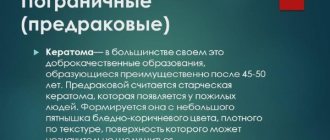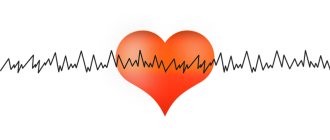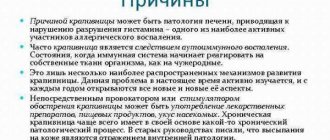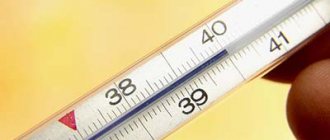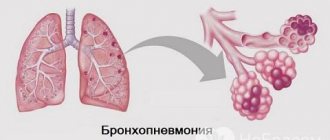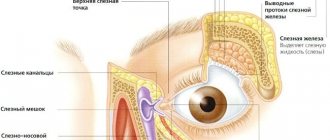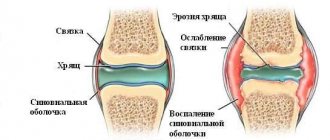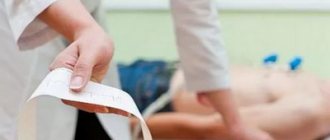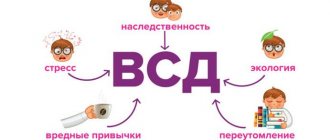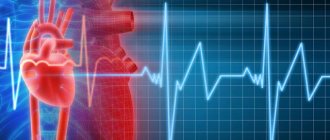What does paroxysmal tachycardia mean?
This type of rhythm disturbance is not a separate disease, but acts as a sign of a number of cardiac pathologies. Attacks of rapid heartbeat arise from ectopic foci of excitation and replace normal contraction. They have different durations (can last several minutes or days), but do not lose their rhythm, which distinguishes the pathology from other arrhythmias. The generation of impulses can originate from the atria, AV junction, or ventricles.
Paroxysm: why it occurs and where the danger is
Paroxysm is the sudden onset and equally unexpected cessation of tachycardia. In terms of etiology and pathogenesis, rhythm disturbance is similar to volley extrasystole, when several complexes are recorded on the ECG at once.
A possible reason for the development of attacks is a congenital human feature - the presence of additional conducting fibers. In children and adolescents, an idiopathic form of paroxysmal tachycardia is sometimes detected. Its essence is to increase the activity of the sympathetic nervous system against the background of emotional overload and hormonal imbalance.
Typically, the onset of an attack in a patient is marked by a sensation of a jolt in the heart followed by strong pulsation. At the same time, the patient complains of dizziness, pressing pain behind the sternum and shortness of breath. Occasionally, paresis, muscle weakness and other neurological symptoms appear. At the end of the paroxysm, a large amount of clear urine with a low level of density may be released.
When ventricular tachycardia develops, you should seek immediate treatment. An acute condition requires hospital care under the guidance of experienced personnel. If it is not stopped in time, the consequences can be severe. Severe disruption of blood flow causes pulmonary edema, cardogenic shock, heart attack, and death.
What tachycardias are paroxysmal
By localization:
- Supraventricular (atrial and atrioventricular). They are registered in 90% of all cases. The supraventricular form of the disorder may result from the influence of the sympathetic nervous system under stressful conditions.
- Ventricular (occurs in 10% of patients with paroxysmal tachycardia). The impulse originates in the Purkinje fibers or the His bundle. The reason for this is a number of organic pathologies of the heart (scar changes, dystrophy, necrosis or inflammation of the myocardium). I usually see this type of palpitation in older men with hypertension, coronary artery disease, defects or myocarditis. In women, it may appear during the postmenopausal period.
With the flow:
- acute;
- chronic (recurrent);
- continuously relapsing - is the most dangerous and difficult to treat.
According to the mechanism of appearance:
- reciprocal (occur due to repetition of the impulse input and further circular excitation);
- ectopic (arise from a specific focus);
- multifocal (involve activity from several points of the conduction system);
- “pirouette” type (has a gradual increase and decrease in amplitude).
Causes
The usual causes of supraventricular tachycardia are an increase in the normal automatism of the heart, most often associated with a violation of its innervation - the conduction of impulses from the autonomic nervous system. Rarely, the cause is damage to those heart muscle cells that produce electricity that maintains the heart rhythm, which occurs as a result of inflammation or chronic intoxication.
In patients taking cardiac glycosides, tachycardia may occur when taking excessively high doses of these drugs. The automaticity of the heart can be enhanced by hormonal factors, for example, hyperfunction of the thyroid gland.
There are supraventricular tachycardias associated with changes in the myocardium of the atria or atrioventricular node. For example, between two excitation centers more than one path of impulses with different characteristics arises.
ECG signs
The basic method for determining paroxysmal tachycardia is a cardiogram. Since the deviation can only be recorded during an attack, Holter monitoring is used.
Depending on the location of the ectopic focus, the ECG picture will be as follows:
- The atrial form of the disorder is accompanied by unchanged ventricular complexes, and the P wave is located in front of them, but at the same time it is reduced or deformed.
- With a rhythm from the AV junction, the atrial wave may be behind the QRS or overlapped with it.
- Ventricular paroxysmal tachycardia on the ECG is manifested by significant deformation of the main complexes.
In all cases the RR intervals are the same. But with ventricular tachycardia, heart rate does not exceed 180 beats/min. And the supraventricular form occurs with a pulse rate of up to 220/min. and even more.
Complications
With frequent attacks, deterioration of myocardial contractile function and heart failure may occur. In such conditions, coronary blood flow decreases, oxygen starvation of the myocardium develops, which threatens necrosis and infarction.
A dangerous complication of atrial tachycardia can be ventricular fibrillation - a chaotic contraction of muscle fibers that can cause blockage of the atria due to the proximity in time of contraction of the atrium to the ventricle, the coincidence of the onset of atrial contraction with ventricular systole.
This causes blockage of the atria, leading to the formation of a blood clot. At the end of the attack, when the main center of automaticity restores its influence on the myocardium, these blood clots can cause blockage of the pulmonary artery.
A dangerous side effect of ventricular tachycardia is ventricular fibrillation. It is a symptom of a heart attack, accompanied by characteristic ECG readings during an attack:
- there is a negative position for the T peak;
- the QT segment increases;
- The ST segment shifts.
Giving help
Treatment of paroxysmal tachycardia should be carried out taking into account its type, the cause of its occurrence, the likelihood of complications and the degree of cardiac dysfunction. In my practice, idiopathic variants, regardless of location, have a favorable course and prognosis. Such forms are well controlled by antiarrhythmic drugs. Hospitalization is required for any type of ectopia coming from the ventricles, and for other types of arrhythmia that threaten to develop into fibrillation or can cause heart failure.
Elimination of an attack
The treatment protocol for paroxysmal tachycardia includes:
- antiarrhythmic drugs;
- glycosides;
- beta blockers;
- "Lidocaine";
- adrenomimetics;
- potassium salts (for supraventricular disorders);
- magnesium salts (for ventricular problems).
Since paroxysmal tachycardia in most cases is a sign of another disease, relief should be carried out simultaneously with eliminating the underlying problem.
In severe cases, electrical pulse therapy or surgery is used (radiofrequency ablation, mechanical excision of additional conduction pathways, cryogenic or laser effects on excitation areas).
According to recent studies, it is recommended not to use first-generation antiarrhythmics due to many side effects. It is better to choose beta blockers to stop an attack. Sotalol has a good effect in this pathology, as it combines inhibition of b-receptors and the basic properties of Amiodarone.
Treatment for tachycardia in children
All actions aimed at restoring the rhythm, regardless of its origin, in a newborn should be carried out in a hospital setting. To relieve an attack in an older child, you should do the following:
- vagal stimulation (turning the head down, pressing for 30 seconds on the epigastric area, inducing vomiting), paroxysmal atrial tachycardia is best eliminated in this way;
- administration of "ATP" intravenously;
- the use of Cordarone and Digoxin for the supraventricular form;
- ventricular paroxysm is stopped with lidocaine.
Traditional treatment
All methods offered by traditional medicine can only act as additional ones along with the implementation of other recommendations. They use herbs and infusions from them that cause a sedative effect (chamomile, mint, St. John's wort, motherwort), bee products (beebread, honey, dead fruit) and homeopathy.
Expert advice
I would like to recommend that those who suffer from paroxysmal tachycardia take all possible measures to increase vagal influence and reduce activation of the sympathetic nervous system. To do this you should:
- practice meditation, do yoga;
- develop stress resistance;
- reduce consumption of coffee, strong tea, energy drinks;
- reduce the use of spicy seasonings;
- do physical therapy;
- when an attack develops, press on the eyeballs, strain, close your nose and mouth and at the same time try to inhale.
It is possible to independently influence the vagus mechanically only if supraventricular tachycardia appears.
How an attack develops
Supraventricular tachycardia develops suddenly (paroxysmal attack):
- the heart rate increases sharply from 120 to 250 beats per minute;
- at this moment the patient may feel a prick, push, stop or “revolution” of the heart;
- the more frequent the rhythm, the stronger the accompanying symptoms;
- attacks can be short-term (up to 40 seconds) or long-lasting (up to several hours). In chronic supraventricular tachycardia, they drag on for long periods of time (several days) or persist permanently;
- paroxysms can be repeated in volleys, often and at short intervals, or rarely, in single attacks;
- an even heart rhythm is maintained from beginning to end;
- approximately 20% of attacks end suddenly and spontaneously.
Case from practice
A young man, 30 years old, came to see me with complaints of palpitations, which were accompanied by dizziness, shortness of breath and pain in the chest.
He goes in for sports, but there is no increase in paroxysms with increasing physical activity. No abnormalities were found on the ECG; echoCG showed normal myocardium. After Holter monitoring, a clinical diagnosis of atrial tachycardia was made with heart rate = 130–140 beats/min. Treatment with Verapamil was carried out (intravenous administration for a prolonged attack) and a technique for carotid artery massage was indicated. After 5 months, paroxysms were practically not observed, and isolated cases were quickly eliminated by vagal stimulation.
Disease prevention
Prevention of the occurrence of paroxysms of supraventricular tachycardia is the timely identification and treatment of the underlying disease - the cause of the pathology (cardiomyopathy, heart disease, endocrine diseases).
Persons who are prone to tachycardia attacks should avoid taking alcohol and drugs. Contact with industrial and household toxic substances must be eliminated.
Medical supervision and prophylactic use of antiarrhythmic drugs are recommended, and, if necessary, surgical treatment of the disease.
